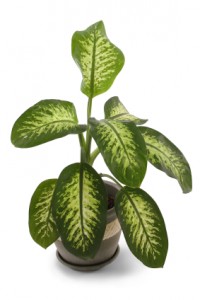Attack of the Killer Houseplant

I recently had a patient come in to my office complaining of pain and irritation in her right eye. While that complaint is common, this time it was anything but common. The cause? She was in her home, minding her own business, when (allegedly) she was attacked by a Dieffenbachia.
Ok, well maybe it wasn’t quite as dramatic as that.
Dieffenbachia is a common house plant native to the tropics, and the sap of this plant contains a compound that can cause a good bit of irritation after contact with skin or soft tissues. The substance secreted by the plant contains calcium oxalate, which crystallizes into structures known as raphides. These raphides are, in the case of our friend Dieffenbachia, needle-like structures that cause irritation. This is believed to be a defense mechanism for the plant to avoid ingestion. The amazing thing, described in a 1995 article in the British Journal of Ophthalmology, is that the raphides are contained in “ejector pods” known as idioblasts which expel the crystals with “explosive force” when subjected to even mild pressure.
Redness and swelling of the eye
Erythema (redness) and edema (swelling) can result from contact with that sap, especially if ingested. Fortunately the symptoms aren’t dangerous or permanent, despite the dire warnings of a chain email that went around a few years ago warning everyone to rid themselves of the scourge of their houseplants immediately (if not sooner). While it is possible for ingestion to cause severe symptoms (difficulty breathing or swallowing, respiratory compromise), this is only common in smaller non-human animals. According to the article referenced above, the plant sap was used in the West Indies as a torture technique during the era of the slave trade.
My patient didn’t ingest the plant, but rather accidentally got some of its sap in her eye. Those calcium oxalate crystals can get embedded in the cornea and cause a temporary pain, redness, blurred vision, tearing, and foreign body sensation. Other houseplants such as philodendrons also contain a similar substance. Additionally, nature has found alternative means by which to cause similar problems for people. The other example that comes to mind is that of tarantula hair, which can cause a great deal of misery if it comes in contact with the eyes.
Handling tarantulas certainly seems more risky than handing houseplants, but I’m not sure my unfortunate victim of a chance encounter with Dieffenbachia would agree.



